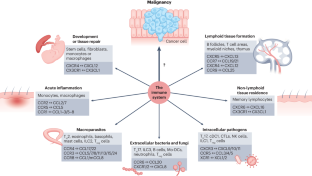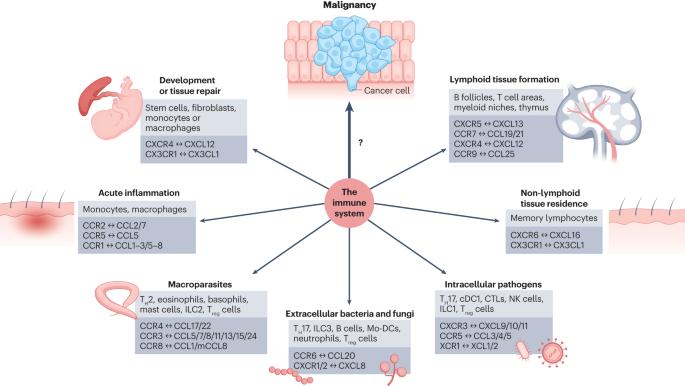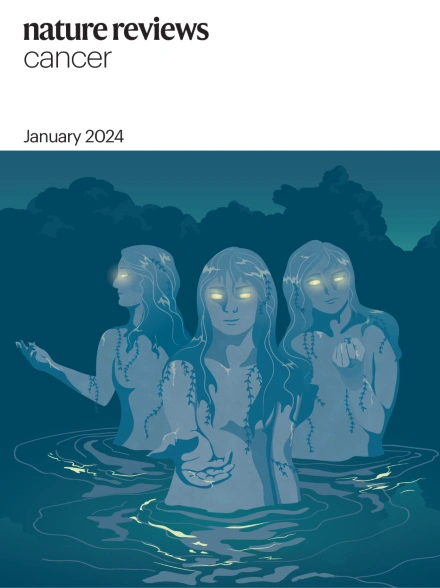How chemokines organize the tumour microenvironment
IF 72.5
1区 医学
Q1 ONCOLOGY
引用次数: 0
Abstract
For our immune system to contain or eliminate malignant solid tumours, both myeloid and lymphoid haematopoietic cells must not only extravasate from the bloodstream into the tumour tissue but also further migrate to various specialized niches of the tumour microenvironment to functionally interact with each other, with non-haematopoietic stromal cells and, ultimately, with cancer cells. These interactions regulate local immune cell survival, proliferative expansion, differentiation and their execution of pro-tumour or antitumour effector functions, which collectively determine the outcome of spontaneous or therapeutically induced antitumour immune responses. None of these interactions occur randomly but are orchestrated and critically depend on migratory guidance cues provided by chemokines, a large family of chemotactic cytokines, and their receptors. Understanding the functional organization of the tumour immune microenvironment inevitably requires knowledge of the multifaceted roles of chemokines in the recruitment and positioning of its cellular constituents. Gaining such knowledge will not only generate new insights into the mechanisms underlying antitumour immunity or immune tolerance but also inform the development of biomarkers (or ‘biopatterns’) based on spatial tumour tissue analyses, as well as novel strategies to therapeutically engineer immune responses in patients with cancer. Here we will discuss recent observations on the role of chemokines in the tumour microenvironment in the context of our knowledge of their physiological functions in development, homeostasis and antimicrobial responses. In this Review, Mempel et al. use our understanding of the physiological response programmes of the immune system to the more commonplace challenges it encounters as a framework to interpret observations of chemokine function in tumours. When viewed in this way, the design of more effective therapeutic interventions leveraging the chemokine system to recalibrate response patterns to cancer might be possible.


趋化因子如何组织肿瘤微环境
我们的免疫系统要遏制或消除恶性实体瘤,髓系和淋巴系造血细胞不仅必须从血液外渗到肿瘤组织,还必须进一步迁移到肿瘤微环境的各种特化龛位,与非造血基质细胞以及最终与癌细胞发生功能性相互作用。这些相互作用调节着局部免疫细胞的存活、增殖扩张、分化及其促瘤或抗瘤效应功能的执行,共同决定着自发或治疗诱导的抗肿瘤免疫反应的结果。这些相互作用都不是随机发生的,而是经过精心安排的,并严重依赖于趋化因子(一大类趋化细胞因子)及其受体提供的迁移指导线索。要了解肿瘤免疫微环境的功能组织,必然需要了解趋化因子在其细胞成分的招募和定位过程中发挥的多方面作用。获得这些知识不仅能让人们对抗肿瘤免疫或免疫耐受的机制有新的认识,还能为基于空间肿瘤组织分析的生物标记物(或 "生物模式")的开发提供信息,以及为治疗癌症患者的免疫反应工程学研究提供新的策略。在此,我们将结合我们对趋化因子在发育、稳态和抗微生物反应中的生理功能的了解,讨论最近观察到的趋化因子在肿瘤微环境中的作用。
本文章由计算机程序翻译,如有差异,请以英文原文为准。
求助全文
约1分钟内获得全文
求助全文
来源期刊

Nature Reviews Cancer
医学-肿瘤学
CiteScore
111.90
自引率
0.40%
发文量
97
审稿时长
6-12 weeks
期刊介绍:
Nature Reviews Cancer, a part of the Nature Reviews portfolio of journals, aims to be the premier source of reviews and commentaries for the scientific communities it serves. The correct abbreviation for abstracting and indexing purposes is Nat. Rev. Cancer. The international standard serial numbers (ISSN) for Nature Reviews Cancer are 1474-175X (print) and 1474-1768 (online). Unlike other journals, Nature Reviews Cancer does not have an external editorial board. Instead, all editorial decisions are made by a team of full-time professional editors who are PhD-level scientists. The journal publishes Research Highlights, Comments, Reviews, and Perspectives relevant to cancer researchers, ensuring that the articles reach the widest possible audience due to their broad scope.
 求助内容:
求助内容: 应助结果提醒方式:
应助结果提醒方式:


